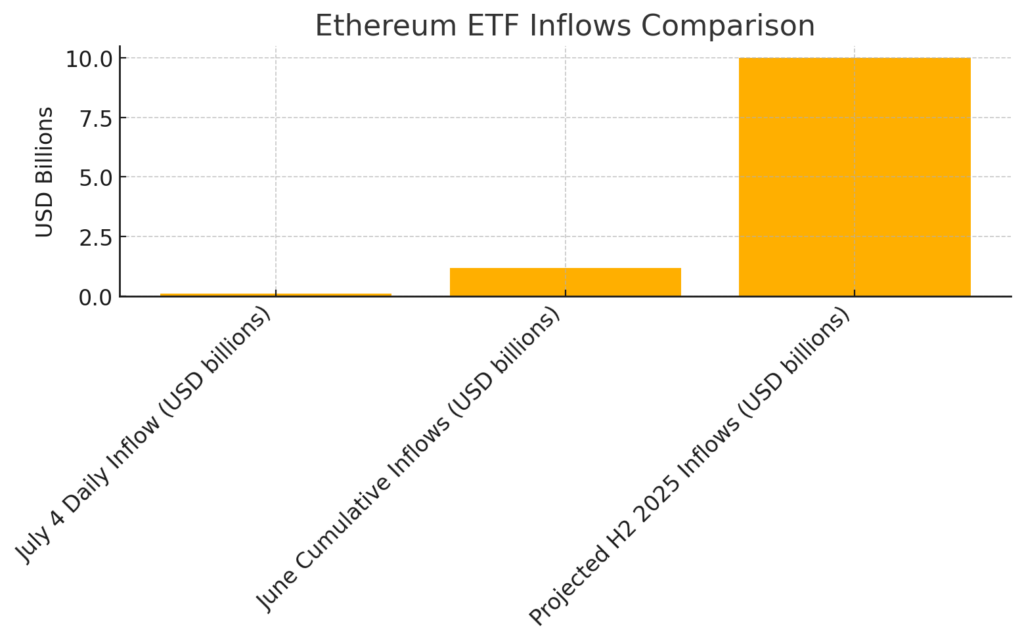
Main Points:
- Massive Inflows: U.S. spot Ethereum ETFs saw a net inflow of 36,439 ETH (≈$92 million) on July 4, with June cumulative flows at $1.17 billion and projected $10 billion by year-end.
- Bridging TradFi and DeFi: ETF approval lowers barriers, enabling institutional and retail investors to access Ethereum via familiar brokerage accounts, reinforcing the fusion of traditional finance and blockchain technology.
- Wealth-Building Strategies: Long-term holding, portfolio diversification (combining Ethereum ETFs, other crypto assets, and traditional instruments), and staking yield offer pathways toward substantial returns, potentially making “crypto millionaires” a reality.
1. The Shock of ¥1 Trillion Inflows into Ethereum ETFs
In early July 2025, U.S. spot Ethereum ETFs recorded unexpectedly strong capital inflows. On July 4 alone, investors poured in 36,439 ETH, equivalent to ¥1 trillion (≈$7.4 billion / ¥135 per $) into these products. In dollar terms, this translated to $92.19 million, building on $148.57 million the previous day, and bringing June’s total to $1.17 billion.
This “one-two punch” of daily and monthly inflows underscores growing institutional confidence. Bitwise CIO Matt Hougan projects cumulative inflows could reach $10 billion by the end of 2025, driven by ongoing demand from pension funds, asset managers, and high-net-worth individuals seeking diversified exposure to blockchain’s second-largest network.
Figure 1: Ethereum ETF Inflows Comparison

(See chart above: July 4 daily inflow, June cumulative inflows, projected H2 inflows.)
2. “TradFi Meets DeFi”: How Ethereum ETFs Transform Accessibility
2.1 Lowering the Barrier to Entry
Before ETF approvals, investing in Ethereum typically required direct coin purchases on crypto exchanges, often perceived as complex and risky. Spot ETFs granted under the U.S. Investment Company Act now allow investors to trade ETH directly through standard brokerage accounts—just like buying shares of Apple or Gold ETFs.
2.2 A Proven Playbook: Bitcoin ETFs as Precedent
The success of Bitcoin ETFs—approved in January 2024—set the stage. Within months, spot Bitcoin ETFs attracted tens of billions of dollars, validating the ETF wrapper as a mainstream investment vehicle. Ethereum’s turn has catalyzed similar expectations, with market watchers citing Bitcoin’s example as evidence that easy access translates to robust inflows.
2.3 Operational Efficiencies and Security
Ethereum’s blockchain underpins decentralized finance (DeFi) protocols and NFTs, prized for transparency and programmable transactions. Integrating these benefits into regulated products could streamline cross-border settlements, reduce counterparty risk, and automate compliance via smart contracts—transformations poised to ripple across global finance.
3. Charting a Path to “Crypto Millionaire” Status
3.1 Embracing a Long-Term Horizon
Volatility is intrinsic to cryptocurrencies. Investors aiming for outsized gains—akin to Japan’s “億り人”—must adopt a patient stance. By focusing on Ethereum’s robust ecosystem growth, from DeFi innovation to Web3 applications, long-term holders can capitalize on technology-driven value appreciation rather than chasing short-term price swings.
3.2 Diversification for Risk Management
No single asset guarantees success. A balanced portfolio might allocate a core position to Ethereum ETFs, complemented by altcoins with strong fundamentals (e.g., Solana, Cardano), stablecoins for yield, and traditional assets like equities or bonds. This diversified approach reduces the impact of market downturns on overall wealth.
3.3 Leveraging Staking Yields
Staking ETH through on-chain mechanisms or ETF-linked staking programs can generate passive income—currently averaging 4–6% annually on major platforms. Reinvesting staking rewards compounds returns, enhancing total yield over multi-year investment horizons.
Conclusion: A New Frontier for Crypto Asset Development
The unprecedented inflows into Ethereum ETFs—¥1 trillion on a single day and projected $10 billion by year-end—signal a watershed moment. As institutional and retail investors embrace familiar ETF vehicles, the traditional finance and crypto worlds converge, unlocking efficiencies and trust previously out of reach. For those aiming to harness this momentum, a disciplined strategy combining long-term conviction, portfolio diversification, and staking income may pave the way to transformative returns. In this new era, the dream of becoming a “crypto millionaire” is no longer mere fantasy but an achievable milestone for informed investors.

